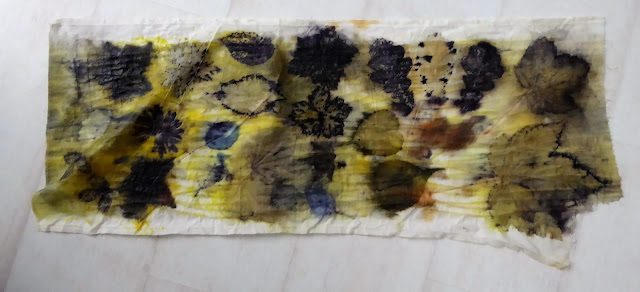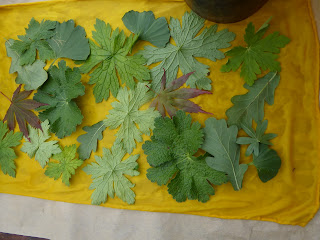Having a plant contact dye plant bundle ready to unroll adds a fine frisson of expectation to my morning cup of tea. I've been experimenting with a technique new to me and trying out the effects of various leaves when laid on plant dyed fabric and steamed with an iron blanket - here's the method I've been using.
This silk was mordanted with alum and dyed with Yellow Cosmos flowers. The warm orange colour the flowers gave the fabric is modified to a duller, darker shade where the iron blanket was pressed against it. Some leaves, like this sycamore, have diminished the colour of the silk, while protecting it from the iron blanket, leaving only a dark halo of iron around their edges. Other types of leaves simply act as a resist, keeping the colour from the Yellow Cosmos unchanged beneath them, and a few leave their own dye colours. So far, none I've used have printed more powerfully than this purple from a red grape vine leaf, which has even printed its dye onto the cotton of the iron blanket.
The grape vine leaves are green in early summer, darkening to red in August and already falling this September, though we have yet to have any properly cold nights. Sweeping them up after a week of high winds, I thought I'd try picking some of the remainder and simmering a big handful in an old saucepan for an hour. The water turned deep red and testing with indicator paper showed the dye was strongly acidic.
Taking out three samples from the pot, adding vinegar to one made it slightly more red, while adding soda ash to another instantly shifted the colour to a green brown.
These effects seemed much like those I've seen with berry dyes, which I have found wash out and fade rapidly when exposed to light.
I sieved out the grape leaves from the pot and added a short length of alum mordanted wool tops blended with some silk. After gentle heating and an overnight soak, the wool had turned a beige shade while the silk fibres had gone pink, which I've seen once before, when dyeing with deep pink hollyhock flowers.
On that occasion, a hot steam iron instantly reduced the colour.
I thought I'd have another look at the first vine leaf printed silk, only to find my companion had been wearing it to go swanning around Cardiff.
"Make the most of that purple leaf print while it's still there, Elinor. When I wash and iron the silk, I don't think the dye will last."
"Just give it a little rinse. You've nothing much to do today, hand wash it for me and it'll be fine."
I put the scarf through the delicates cycle in the washing machine at 30 degrees centigrade with a pH neutral detergent. To my surprise, the colour only dimmed a bit and survived a steam iron. My companion scooped it back up and slung it round her neck. She twirled for me to admire her outfit.
"Off to Cardiff again, are you?"
"We can't all be playing in the garden all day. Some of us have to work, Beaut."
"Ooo. Have you got a part in another film, or is it TV this time?"
Elinor posed as if to leap into the shrubbery with two guns blazing.
"Starring in a video game, Beaut. Today I shall be shooting aliens in the face."
"In a silk scarf?"
"In Virtual Reality, anything is possible. The computer nerds think purple leaf prints are hip, so #@me next time."
I stared at her.
"You want me to dye another scarf for you?"
"Activate Beast Mode, Beaut. Those leaves will soon be gone."
Which I took to mean yes.
I reckon the purple colour in these leaves must be an anthocyanin. Reading around on the internet, it seems that anthocyanins cause the dramatic colour change seen in some autumn leaves. Fugitive dyes, such as those from berries and red cabbage and hollyhocks are also made by anthocyanins. While it was too soon to say much, the first grape leaf print had at least performed better than berry dyes in the wash. I think this is unlikely to be because of tannins in the leaves, because blackberries have a high tannin content too. Maybe the iron blanket helped, or maybe grape vine leaves contain a different type of anthocyanin.
Anyway, I have printed two more silk scarves, alum mordanted but with no base layer of plant dye. One was was laid out with leaves dipped in a dilute iron solution (right) the other was rolled with an iron blanket (left). Both had a few of the last coreopsis flowers scattered among the leaves. I think the reason most of these prints are paler than last week is because now, most of the leaves are withering and curling up on the vine. Very pretty, though. I'll just have to wait and see how well the anthocyanin pinks and purples stand up to washing and wearing. Not to mention shooting aliens in Beast Mode.
This silk was mordanted with alum and dyed with Yellow Cosmos flowers. The warm orange colour the flowers gave the fabric is modified to a duller, darker shade where the iron blanket was pressed against it. Some leaves, like this sycamore, have diminished the colour of the silk, while protecting it from the iron blanket, leaving only a dark halo of iron around their edges. Other types of leaves simply act as a resist, keeping the colour from the Yellow Cosmos unchanged beneath them, and a few leave their own dye colours. So far, none I've used have printed more powerfully than this purple from a red grape vine leaf, which has even printed its dye onto the cotton of the iron blanket.
The grape vine leaves are green in early summer, darkening to red in August and already falling this September, though we have yet to have any properly cold nights. Sweeping them up after a week of high winds, I thought I'd try picking some of the remainder and simmering a big handful in an old saucepan for an hour. The water turned deep red and testing with indicator paper showed the dye was strongly acidic.
Taking out three samples from the pot, adding vinegar to one made it slightly more red, while adding soda ash to another instantly shifted the colour to a green brown.
I sieved out the grape leaves from the pot and added a short length of alum mordanted wool tops blended with some silk. After gentle heating and an overnight soak, the wool had turned a beige shade while the silk fibres had gone pink, which I've seen once before, when dyeing with deep pink hollyhock flowers.
On that occasion, a hot steam iron instantly reduced the colour.
I thought I'd have another look at the first vine leaf printed silk, only to find my companion had been wearing it to go swanning around Cardiff.
"Make the most of that purple leaf print while it's still there, Elinor. When I wash and iron the silk, I don't think the dye will last."
"Just give it a little rinse. You've nothing much to do today, hand wash it for me and it'll be fine."
I put the scarf through the delicates cycle in the washing machine at 30 degrees centigrade with a pH neutral detergent. To my surprise, the colour only dimmed a bit and survived a steam iron. My companion scooped it back up and slung it round her neck. She twirled for me to admire her outfit.
"Off to Cardiff again, are you?"
"We can't all be playing in the garden all day. Some of us have to work, Beaut."
"Ooo. Have you got a part in another film, or is it TV this time?"
Elinor posed as if to leap into the shrubbery with two guns blazing.
"Starring in a video game, Beaut. Today I shall be shooting aliens in the face."
"In a silk scarf?"
"In Virtual Reality, anything is possible. The computer nerds think purple leaf prints are hip, so #@me next time."
I stared at her.
"You want me to dye another scarf for you?"
"Activate Beast Mode, Beaut. Those leaves will soon be gone."
Which I took to mean yes.
I reckon the purple colour in these leaves must be an anthocyanin. Reading around on the internet, it seems that anthocyanins cause the dramatic colour change seen in some autumn leaves. Fugitive dyes, such as those from berries and red cabbage and hollyhocks are also made by anthocyanins. While it was too soon to say much, the first grape leaf print had at least performed better than berry dyes in the wash. I think this is unlikely to be because of tannins in the leaves, because blackberries have a high tannin content too. Maybe the iron blanket helped, or maybe grape vine leaves contain a different type of anthocyanin.
Anyway, I have printed two more silk scarves, alum mordanted but with no base layer of plant dye. One was was laid out with leaves dipped in a dilute iron solution (right) the other was rolled with an iron blanket (left). Both had a few of the last coreopsis flowers scattered among the leaves. I think the reason most of these prints are paler than last week is because now, most of the leaves are withering and curling up on the vine. Very pretty, though. I'll just have to wait and see how well the anthocyanin pinks and purples stand up to washing and wearing. Not to mention shooting aliens in Beast Mode.



















































